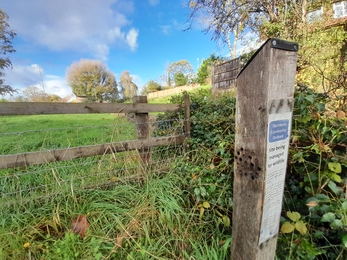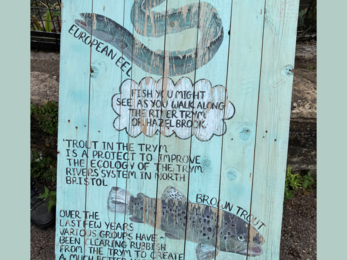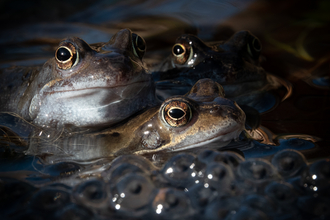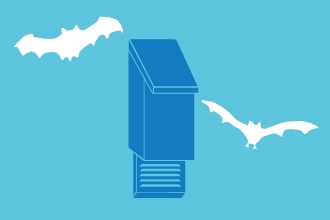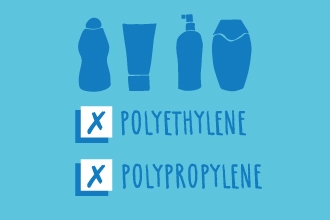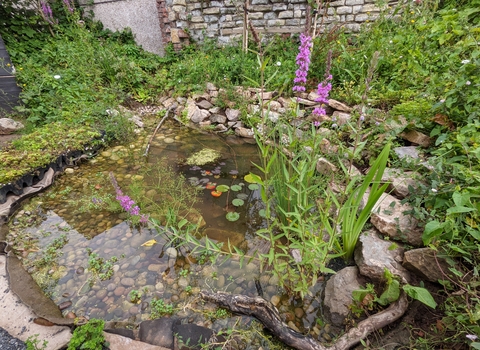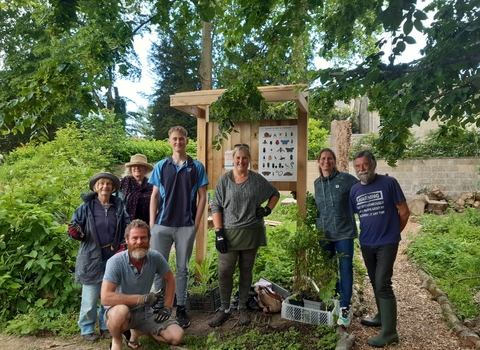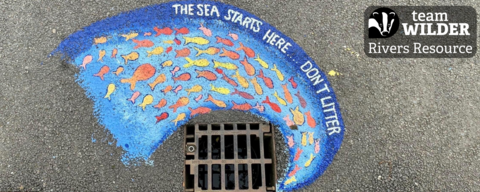
Trout in the Trym
Rivers and brooks near to you
The awesome power of flowing water shapes the landscape and creates an essential habitat to support people, plant and animal life survival. How the river bed, banks and surrounding landscape is used has a huge impact on local wildlife. Impacts include flooding, drought, pollution, habitat loss and creation.
River conservation involves looking at the entire river system, working with local authorities, organisations, community groups and local people to create a broad range of activities to benefit people and wildlife. This is a Catchment Based Approach.
Many species rely on water habitats including beavers, kingfishers, water voles, trout, eels, dragonflies, mayflies, ducks, heron, little egret, not to mention visitors such as fox, deer and other mammals.
(c) Bevis Watts
Actions people are taking at home
Trout in the Trym and SusWOT in BS9, champion many actions that people can take to help their local waterways. All actions for nature make a big difference, collectively. Here are a few ideas:
- Save water - install a water butt and conserve water with everyday tasks
- Be mindful of what goes down the drain
- Report sewage and pollution Trout in the Trym are very organised about reporting issues.
- Litter pick when out and about
- Share wildlife sightings near the water
- Sustainable living
If you have a garden, there are many actions you can take, no matter the size of the space
- Limit concrete and plastic coverings so that rain water is absorbed naturally,
- Wildlife gardening small actions make a big difference
- Chemical free gardening and food growing
Join or start a community group to help protect your local waterways.
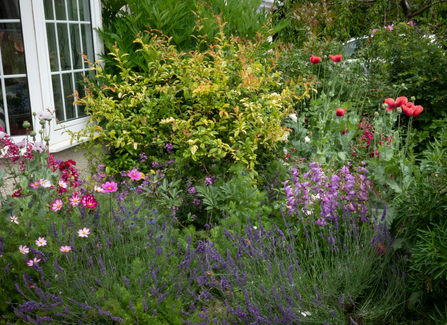
Stephanie Chadwick
Community groups have the power to improve local waterways
There are some great examples of community groups taking action for their local rivers and brooks. See below for ideas and advice to do this.

Sophie Bancroft
Actions taken by community groups near the river
- Litter picking and river cleaning
- Himalayan balsam pulling
- Wildlife surveying
- Community events and education
- Water quality reporting
- River channel management
- Thinning woodland
- Planting native wildflowers to reduce erosion
- Campaigning
It feels good to do something positive and make a difference to the local environment. With (Trout in the Trym) we have the power to improve our waterways. It's so beautiful.Trout in the Trym volunteer
Litter picking and river cleaning
Litter picking. Trout in the Trym and SusWOT are very experienced with successful litter picks in their local area, including near and in the river systems. They shared the following advice:
- They developed a good relationship with Bristol Parks, who take away the rubbish and are part of the team.
- Hold regular litter picks - on the same day and time each week, making it easier for people to attend.
River Cleaning. Historical litter builds up over time and has a negative effect on wildlife and pride in the area. Fly tipping in rivers and streams can encourage further anti-social behaviour in the area.
Trout in the Trym systematically work their way along the river, clearing litter and improving habitat spaces via regular work parties. Volunteers interested are told where to meet and some are very experienced. New people come along to volunteer sometimes miss litter, but this no problem and expected.
Himalayan balsam pulling
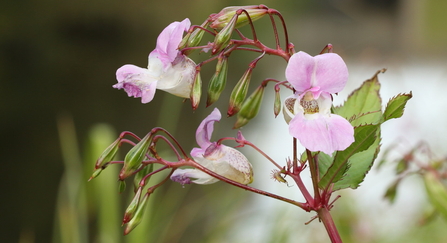
Vaughn Matthews
Many community spaces near flowing water experience the rapid colognisation of the non-native himalayan balsam. It loves shady areas near water and presents a big problem, as the structure of the soil is altered and increases erosion in the winter. Himalayan balsam suppresses native wildflowers.
Trout in the Trym have a good plan to eradicate himalayan balsam, plus advice is given on the Invasive Non-Native Species (INNS) resource below:
Wildlife surveying

WildNet - Irene Greenwood
Wildlife surveying is a great way to raise awareness of what wildlife is in the area and sharing sightings increases interest and chances of protecting local habitat spaces. Surveying can also be called a bioblitz or citizen science. It can be done as a group on individually. Apps like inaturalist make surveying accessible, fun and easy for people to get involved with – the app makes suggested species identifications and uses the data for national records.
Citizen Wildlife reporting resource
Community events and communication

Blooming Whiteway
Community events are a great way to spread your message face-to-face and bring people together to speak about how and why they would like to get involved and also barriers stopping them from volunteering. How people use the river and connect with the local space, what it means to them, local history and memories are important. Some people want to 'do their bit' for the community and/or local environment and climate or ecological emergency.
Leaflets and local signs are also great ways to communicate what's happening and how people can get involved. Plus email, social media and WhatsApp groups help to spread the word.
Water quality reporting & reporting pollution
Trout in the Trym and SusWOT are very active in championing sustainable ways of living, including the effect of this on their local waterways. Monitoring the quality of the water provides a great way to know what difference they are making to the area through their actions. One of the organisers, is interested in water quality and monitors this. His report is very useful: water quality report.
The group are very organised about who to contact at Wessex Water and the Environmental Agency, in regards to sewage, pollution and general water quality. Their website cleverly shows specific webpages and phone numbers. Trout in the Trym are good at educating others to make a difference and not just moan.
- Bristol: Reporting water quality - who to contact in Bristol
- South Gloucestershire: Report water pollution to South Gloucestershire Council
- Bath and North east Somerset: Report pollution to BANES Council and River and Canal info
- North Somerset: Report pollution and flooding issues
Conham Bathing group are a group of local swimmers and are campaigning for water quality enhancement of the River Avon. They have some very useful links on their website about how much sewage is in the river right now, water sampling reports, public surveys, useful information about their council debate and bathing water status. Find out more and get involved.
Enhancing woodland habitat space near water

Esther Frizell-Armitage
Allowing more light to reach the water course
Trees are an important component of river corridors. They provide shade in the river, which helps to cool the water, and also offer food and shelter opportunities for wildlife too. However, it is important to regularly manage the trees alongside waterbodies as they can begin to shade out the waterbody. The over shading of the water can then stop plants from growing in the river as plants need access to light in order to grow. Plants then help to benefit the wider ecosystem through providing shelter and food as well as adding structural diversity to the habitat. Therefore, by thinning the woodland alongside the steam, the following benefits can be achieved:
- more light is allowed to reach the water
- help aquatic plants to establish and grow
- improve the water quality of the water
The Team Wilder Community Ecologist visited a landowner about Dymocks Wood, which has a watercourse running through it. Advice was given to thin the woodland in order to allow more light to reach the water. Click the link below for more detail about how to do this.
Dymocks Wood - advice to thin woodland
Managing cow parsley
The thinning of the woodland may help to reduce the cow parsley from dominating. Cow parsley can be cut in early spring before it flowers. This will weaken the plant. Repeated cutting after this will provide some short-term control and will then allow other understorey plants to grow.
Bird and bat boxes
It was recommend to install bird and bat boxes on the trees. Bird boxes should go on the northern or eastern elevations and bat boxes should go on the southern or eastern elevations.
The Malago River in Manor Woods Valley
Manor Woods Valley Local Nature Reserve is a haven for wildlife. The community group meet regularly and manage the site, including wildflower meadows, community orchard and woodland, create wildlife habitats and use the site to help educate others. They have also created some useful and impactful reports. A water quality report mapped out part of the river and investigated water quality and aided other ecological surveys. Following this scientific research, a number of strategies to maintain the quality of the Malago River and the health of the aquatic life it supports were suggested:
● A strategy to prevent plastic littering in and around the river: microplastics accumulated downstream suggesting they are sourced from within the reach. A campaign will reduce the inevitable breakdown of this litter into microplastics and reduce the harmful impact this has on aquatic life.
● A campaign to encourage the public to pick up after their dogs when walking: E-coli is harmful to aquatic life and predominantly stems from faecal contamination. Because E-coli counts have often been observed to exceed Environment Agency standards for bathing water, the picking up of animal waste in the surrounding area would benefit the river’s health.
● Regulation of the extent of fertilizer used in the allotments: Fertilizers contain ammonia, which can deplete aquatic populations if found in excess in rivers. The concentrations of ammonia identified in the river fell comfortably within high quality Environmental Agency standards, however, the results were taken during dry weather conditions, when there was little or no runoff from the river banks. Limiting runoff from ammonia fertilizers is encouraged.

Sophie Bancroft
BART (Bristol Avon Rivers Trust) met with Manor Woods Valley LNR in May 2022/3 and created a site surveys for the Malago, Pigeonhouse Stream, and Colliters Brook. Specific advice regarding habitat diversity and connectivity and recommended community actions to improve the rivers and catchments. Recommendations:
- Installation of woody debris - to increase flow variability, trap sediment, encourage marginal vegetation and add more light to the water where the Malago river has previously been straightened, NB Permission and a Flood Risk Activities Permit (FRAP) from the Environment Agency is required.
- Tree and hedge planting for valuable habitat creation. NB Permission, training, insurance and selecting the right native tree and hedge varieties with long-term management plans are essential.
- Coppice the hazel to maintain healthy trees and create wildlife habitat.
- Remove non-native plants, such as Laurel to make space for native species of wildflowers, hedges and tree's.
- Monthly water monitoring, help is available from BART.
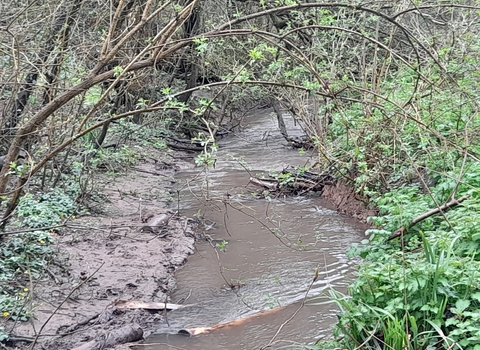
Sophie Bancroft
River management actions for nature to reduce flooding
Challenge: flooding and erosion of the stream bank
- Riparian zone: flooding of the area has changed the ecology and eroded the stream bank. The area is well-used by the public and dogs. A report by BART (Bristol Avon Rivers Trust) recommended improvements to the river corridor and stabilising the bank. Additional advice was given to stabilse the river banks with native planting and minimising future flooding and bank erosion.
Solutions: native plants on the river bank and riparian corridor, berms and leaky dams
- Suitable native species to be planted along the river banks to help stabilise the banks. Additional planting of scrub and other vegetation to minimise the flooding along the riparian corridor.
- The creation of berms and leaky dams within the watercourse to reduce bankside erosion and flooding.
Thornbury Orchard Group received advice from the Team Wilder Community Ecologist about reducing flooding and erosion on the river banks and general river health. This included limiting access to the water for dogs, stabilising the bankside with recommended native vegetation (Nettles, purple loosestrife, common reed, greater pond sedge, yellow flag iris and meadow sweet) and managing this long-term. Goat willow should help stabilise the soil, plus other recommended vegetation. Dead hedging could use coppiced willow to limit access to the water and create a good habitat to support wildlife.
- Natural features such as berms are beneficial and they will diversify the flow, reinstate more natural processes, re-meander the river and create another habitat for riparian species.
- Leaky/woody dams could be created upstream as these features slow the flow of water downstream and also increase sediment/silt retention. Therefore, the feature also increases the water quality downstream. These are recommended to mitigate against the flooding issues and sediment build up.
Learn more about the Team Wilder case studies featured
Specific site reports, recommended actions, more advice, information and pictures about the amazing community groups featured and how to get involved.
Find a community group near you or upload our own group to the Team Wilder Community map.
Resources

(C) Hannah Bunn
Be part of Team Wilder
All actions for nature collectively add up and creates life for people and wildlife.
Share your actions for nature, like Tom by sharing and tagging @avonwt on social media and
Log your actions for nature on the map











